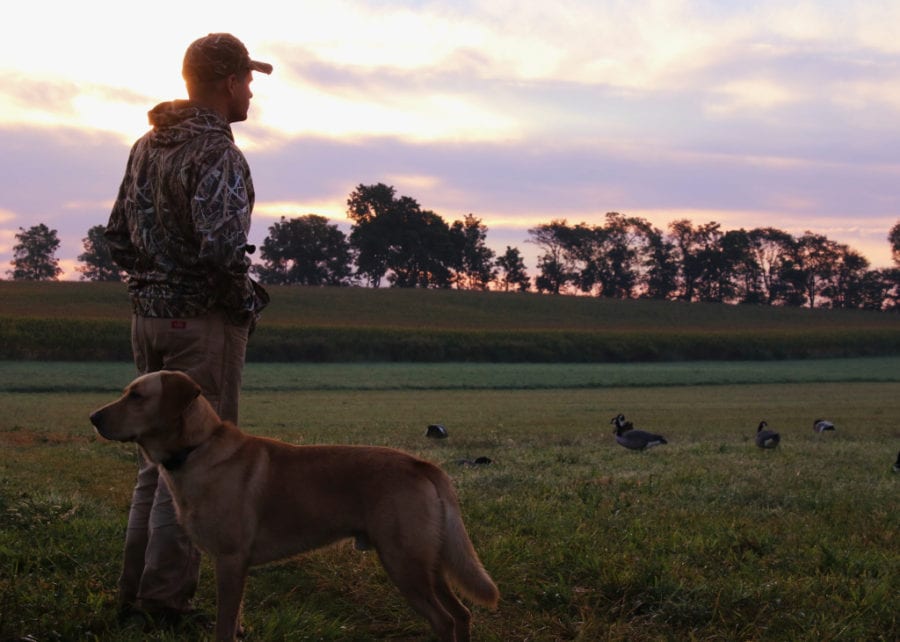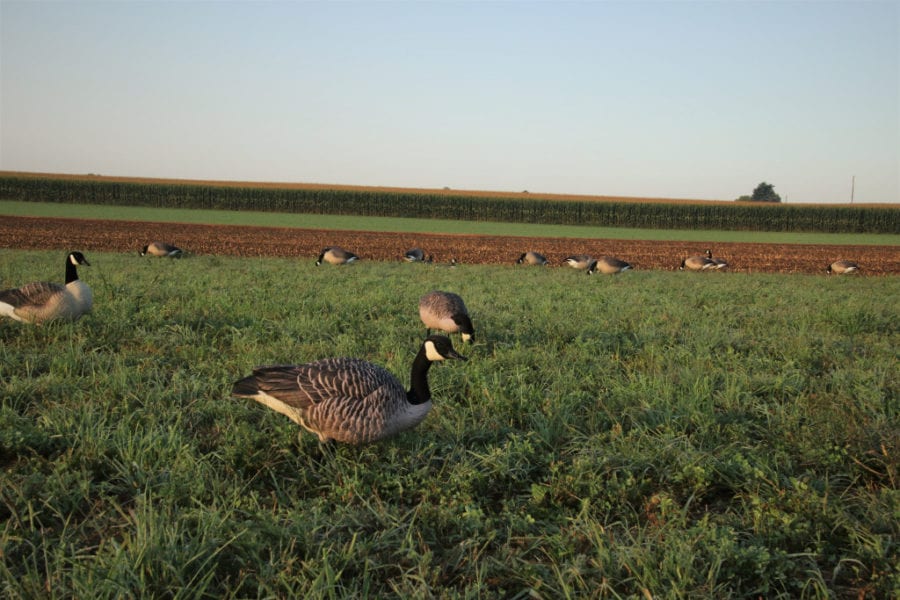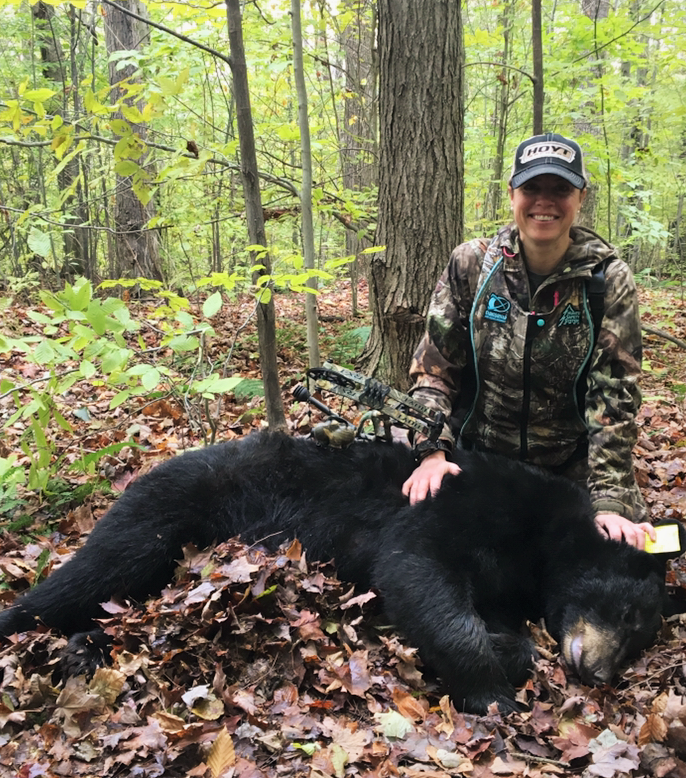By Derek Stoner, Hunter Outreach Coordinator
The heady scent of fresh-cut field corn competed with the odor of cow manure to keep my sense of smell occupied while awaiting the arrival of geese. Scouting efforts revealed that this small flock of Canadas should arrive in the pasture around 7:00am. Patience wavered as I perched on my camo bucket set amidst corn stalks.
A distant but distinctive honk broke the silence. Cresting the hill in front of me, just below the rising sun, a group of eight geese flapped steadily towards my setup. Seeing the dozen goose silhouette decoys on the ground in the short pasture grass, the real geese set their wings and glided in.
Two hundred yards. One hundred yards. At fifty yards, my grip tightened on the pump shotgun.
Clucks erupted from the geese as they set down their landing gear and dropped into the open space between the decoys.
Picking a bird on the right edge first, my first shot dropped the big gander and then two more shots dropped a goose each. The remaining five geese hastily flew back in the direction that they came from.
The only thing missing from this successful September goose hunt was a partner or two to share in the experience and help bag the geese that got away. My friends had decided to sleep in, and they missed out on a fun and quick hunt.
The hunt described here took place almost twenty years ago in Chester County, and the September goose season in Pennsylvania continues to offer the same exciting experience for hunters ready to take on the challenge of these big resident Canadas.
A simple setup with a dozen decoys, a well-scouted location, a shotgun stuffed with BB loads, camo clothes, and a bucket are all that were needed to pull off this hunt for resident geese. Since then, I have been a part of many more hunts for the geese of September and the basic hunt strategy remains the same.
Although many died-in-the-wool waterfowlers dream of dozens of Canadas dropping into a perfect cut corn field on Opening Day and emptying their barrels to collect a true pile of geese, more folks are able to relate to the scenario where you have opportunities to chase smaller numbers of geese on fields or waterways throughout the month.
Hunting resident geese in September does not need to be complicated or expensive in terms of strategy and equipment requirements. Quality opportunities exist to hunt resident geese throughout Pennsylvania, whether in agricultural fields or on bodies of water. Let’s review the key components of putting together a strategic game plan for September geese.

Photo by Derek Stoner.
Scouting
My friend John Witmer, a professional waterfowl guide, chases plenty of geese during the month of September. He notes that “these birds already know where they want to go and spend time each day feeding. Field hunting is more about scouting than anything else.”
Geese in September typically feed in a pattern that develops after the breeding season as the family groups first take wing after the molting period in mid-summer. They tend to not fly very far or very high as they head to their feeding destination for the day. By driving around in the mornings and using a pair of quality binoculars, you can readily locate places attracting geese during this early season. Find a fresh-cut cornfield, a recently-mowed hayfield, or a well-clipped cow pasture, and you will be likely to have the local Canadas visiting that food source soon.
Timing
For most hunters pursuing geese in September, it’s all about the mornings. The geese will often leave their roosting location in the first hour after sunrise and fly directly towards the field where they fed the day before. Being ready to take advantage of the arrival of these birds is critical, as there will likely not be other flights or flocks arriving later in the morning. Allow at least an hour to get set up and settled in before you expect the geese to arrive.
During the warmer days of September, the geese are more settled and “lazy” compared to the cold days of Fall when they feed frantically and fly around a lot more during the day. Typically by mid-morning the geese leave the field and fly back to a location with water to get a drink and spend the middle of the day relaxing.
If your scouting efforts reveal a good place to try for the geese at a mid-day loafing location or a special place they feed in the evenings, then by all means take advantage of that intel and give it a try. Just remember that you may only have one opportunity with these geese, unless there are multiple flocks around that are visiting a common location.

Decoys
If you have a flock of twenty geese coming to a cut cornfield or hayfield, there is no need to put out a spread of two dozen decoys to convince the geese to return to this spot. In fact, the opposite may be true if these geese are not keen on competition. Less is often more and giving the birds space to spread out is critical.
Watching flocks feeding while you are out scouting should give you an idea of how to set your decoys up. During warm weather the birds are usually spaced far apart while feeding and will be with their family groups of adults and a few youngsters. Two separate feeding groups of a half-dozen decoys is a pretty good approximation of what real birds like to see in September.
As for what type of decoys to use, the choice between full-body and silhouettes is a win-win. Use whatever goose decoys you have that are in good condition and look realistic. Old decoys with faded paint may need to be touched up before use. If you don’t have decoys currently, there are plenty of deals online or in stores to get a set of a dozen decoys or by searching online classifieds to buy used fakes. Be sure to put out a variety of decoys in different poses, with many head-down birds that are feeding and a few head-up birds that are keeping watch.
John Witmer states that “we usually run small spreads of mainly silhouettes.” A few of the best September goose hunters I know subscribe to the silhouette school as well, while other folks swear by full-body decoys with the velvet-like flocked coating that looks like real feathers. Whatever decoy type you choose, just remember that realism is critical and that you often only get one chance to convince the birds to land.
Location
There are two primary setup locations for September geese: in the field or on the water. By far the majority of waterfowl hunters gravitate to fields in September, as the first-harvested crops draw hungry geese to these limited resources. Water is an option worth considering, though, as geese will congregate at locations mid-day where they drink, bathe, and loaf around before heading out to feed again in the late afternoon and evening.
Blinds
In order to fool the eyes of geese and convince them to land within range, you need to be very well hidden. For birds in fields, this often means hiding in standing vegetation like cornstalks adjoining a harvested section or a thick hedgerow adjoining a pasture. Sitting on a camp stool or padded bucket seat is a good way to stay comfortable while awaiting geese. This type of “natural blind” works well in that you do not have to actually build anything. Some scenarios allow you to use lightweight camouflage netting or fabric to build a temporary blind for the hunters to hide in.
By far the most popular type of blind to use for goose hunting these days is the layout blind, which allows the hunter to lay on their back with head slightly elevated while their body is enclosed in a camo-clad capsule. Attaching pieces of vegetation to the layout blind—whether cornstalks, dead grass, or cattails— helps the hunter stay well hidden in the blind and conceals movement. If you are hunting a pond or river’s edge, a standard type of standup blind will allow the group of hunters to remain disguised from the eyes of the geese.
Calling
On many a September goose hunt, we never pick up our calls. Unlike during the regular goose season in late Fall when loud and aggressive calling can be necessary, geese in September do not seem to like to hear much noise from other geese.
John Witmer offers these recommendations on calling to geese in September: “Calling is very subtle with soft moans and honks. Less is more on these geese. On rivers or ponds we run small spreads but will be more aggressive with calls because often these birds are returning to water after being pressured.”
Bottom line—do not worry if you do not sound like a champion caller. Giving the geese a few simple calls is often all it takes to convince them to join the spread.
By putting together these simple strategies for approaching your goose hunt in September, you will increase your odds for a successful outing. Find the birds, make a good decoy setup, hide well, and you will find yourself in for a fun time afield.
September Season Basics
The September season for resident Canada Geese runs from September 2 (Labor Day) to September 25 this year. The statewide daily limit is eight geese, with special regulations in the Southern James Bay Population Zone located in the northwestern corner of the state along the Ohio border as well as at the Middle Creek complex in the Southeastern part of the state. To hunt geese, individuals need a hunting license, a federal waterfowl stamp, and the state migratory bird license. Hunters must fill out a HIP (Harvest Information Program) survey when purchasing their license to track waterfowl hunting activity and harvest. Only non-toxic shot may be used for hunting geese.
The views expressed by the editors, authors or users of this linked article are expressly theirs, and do not necessarily reflect the policies or opinions of Dallas Safari Club Northeast, its employees, members or assigns. Any concerns about a site user’s post should be addressed appropriately to that person. Any concerns about an advertiser, a user or any content on this site should be addressed to contact@dscnortheast.org.




